WAIL!... The CBZ Journal |
[Table of Contents] November 2002 |
| Comment | Contact | WAIL! Back Issues | CBZ Masthead |
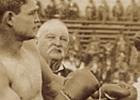 Click for larger view: 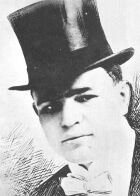

 
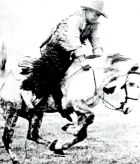



|
Luther McCarty... "Fightin' Cowboy of Wild Horse Canyon" By Tracy Callis and Larry "Cap" Roberts It is July 4, 1918. The place is a large open-air arena outside of San Francisco. A crowd of 10,000 raucous boxing fans is readying itself for the much anticipated main event, Jess Willard's second defense of his World Heavyweight title, with a portion of the gate going towards the Veterans of America Fund. Big Jess ducks through the ropes and eyes his opponent across the ring under the hot California sun. He squints as he recalls their first meeting some six years before in New York City. The memory causes him to rub his jaw with his glove. At ringside, a young fight fan hands boxing writer Nat Fleischer some freshly sharpened pencils and then resumes his seat behind his boss. He sizes up Willard, then shifts his gaze to the man the "Pottawatomie Giant" is staring at. This fellow is tall, though not as tall or as heavy as the champion; maybe 6'3" or 6'4" and about 210-215 lbs. The challenger is said to be 26 years old although he appears older. He sits calmly, unperturbed. His cornerman douses his curly head with water and he shakes it off as he flexes his long sun-bronzed arms. A portly gent in black suit and straw boater, seated beside Fleischer and the kid, points a thumb at the rangy challenger and mutters, "So that's the cowboy, eh?" "Yup" replies the youngster, "That's Luther McCarty alright, same guy that whipped Carl Morris, Fred Fulton and Gunboat Smith. He hasn't lost a fight in five years. Police Gazette says he's the next heavyweight champ." "Pretty good for a dead man" snorts the older man. "What's that supposed to mean?" asks the kid. "Just that Luther McCarty died in a boxing ring in Calgary in 1913 in a fight with Arthur Pelkey." At that, Nat Fleischer whirls around in his seat, glares at the gent and says, "Wake up! Wake up, Harley, you're snoring again." Suddenly, Harley Smith wakes up in his own bed beside his loving wife of twenty years and yells, "It's not 1918! This isn't San Francisco!" His shocked wife stares at him with a puzzled look on her face. Then, Harley remembers that he has to get down to the park to help put up the new stands for the big heavyweight championship fight between Willard and that guy Dempsey. "Holy Toledo!" he grumbles, "Musta been yer mother's sausage," and his thoughts go back to his dream and the money he lost in that Calgary arena five years before. "What a waste, that guy coulda been a champeen." Harley reaches down and picks up the old dog-eared copy of the Police Gazette he'd been reading the night before. At the kitchen table, over a cup of coffee he thumbed through it until he found what he was looking for. There, in faded ink beside an equally dim photo, was a brief account of the rise and fall of Luther McCarty, the "Fightin' Cowboy of Wild Horse Canyon." The mystery that plagued Harley is one that still manages to incite heated conversations amongst fans of the "Sweet Science." Just how good was Luther McCarty? Ranked as the best of the so-called "White Hopes" by many boxing historians, Luther McCarty was tall and agile. He used a long straight left jab effectively. His overhand right was fast and accurate and thrown from the shoulder. His uppercut was cruel and rarely missed. His hooks to the body were paralyzing. He moved well, kept his balance as he attacked and defended himself. He did not waste punches. So impressive was he that DeWitt Van Court (1926 p 86) asserted that McCarty was "unquestionably the greatest young heavyweight prospect since the days of John L. Sullivan." Andre and Fleischer (1991 pp 88 89) spoke of the effort to dethrone Jack Johnson as Heavyweight Champion and named some splendid fighters - Luther McCarty, Carl Morris, Tom Cowler, Fred Fulton, Arthur Pelkey, Gunboat Smith, Frank Moran, Al Palzer and Jess Willard. They wrote, "The 'White Hopes' thrived between 1910 and 1915, and they were a mighty impressive lot, far better than the majority of the contenders in recent years. For a time it seemed that Frank Moran might be the successful candidate, and then the eyes of the boxing world became centered on a better all-around heavyweight, Luther McCarty." What might have been for Luther? Top contender? Definitely, he already was one. Heavyweight Champion? Possibly. Nat Fleischer thought he was the best of the "White Hopes." McCarty was only 21 when the tragic loss to Pelkey took place. Had he lived, filled out, developed and gained experience, he may well have defeated Jack Johnson and been fighting Jess Willard on July 4, 1918. Daniel (1947 p 13) wrote, "It is conceivable that had Luther lived, he would have punched Jess Willard out of his path, and that Luther instead of the ungainly giant from Kansas would have been Johnson's conqueror - and later, Jack Dempsey's antagonist." Fleischer (1936 p 4) asserted, "There was first and foremost, Luther McCarty, the "white hope" champion, the man, who, had he not been killed in the ring by Arthur Pelkey, would have faced Jack Johnson, instead of Jess Willard getting the assignment." McCarty began fighting in 1911 at age 19 and developed rapidly. He fought until 1913 when the fatal incident ended his life and career at Calgary's Manchester Arena. During this time, he had 25 bouts and scored 16 knockouts. In a three months' span, shortly before his death, he knocked out three leading heavyweights of the time - Al Kaufman, "Fireman" Jim Flynn and Al Palzer. Others of note he defeated during his career were Joe Cox, Carl Morris, Jim Barry and Frank Moran. Luther was recognized as the "White Heavyweight Champion" with his win over Palzer on January 1, 1913 at Vernon, California. Declared the New York Times (January 5, 1913), "In his two years of boxing, McCarty has made what is undoubtedly the most impressive ring record in the history of pugilism. He has figured in twenty-two bouts, almost an average of one per month, and the charge cannot be made that he picked the easy ones. Sixteen of the twenty-two bouts have been decided by knockouts or the intervention of the referee to save McCarty's opponent. He fought four ten-round bouts and two six-round affairs which were of the no-decision variety and these alone went the scheduled distance. But it is extremely doubtful if any of the six opponents could last ten rounds against him now. Willard might, but there would be little chance of the others and Willard would have few backers in a twenty-round engagement after the showing made by McCarty against Flynn and Palzer." Officially, he lost only the one battle to Pelkey. But, there were three highly debatable newspaper losses charged to his record - all in 1912; first, against the top black contender Jeff Clark; next, in his "big city" debut bout versus local boy, Jim Stewart; and third, against the formidable "Pottawatomie Giant," Jess Willard. The young McCarty was sporting a 10-1-1 record, actually 10 wins (all knockouts) and 2 no decisions when he tangled with big Carl Morris on May 3, 1912 at Springfield, Mo. The result of this contest garnered some big attention when Luther flattened Morris is the sixth round. The New York Times (May 4, 1912) reported, "McCarty won with a swinging right to the jaw which followed a straight left that had staggered the Oklahoman. Morris went down to the floor for a count of fourteen, and then did not appear to realize that he had lost. The bout prior to the sixth round was even, neither fighter doing much damage." Three weeks after this victory, McCarty KO'd Jack Reed at Joplin, Mo. Then, he traveled east to the big cities and at Philadelphia a month later, defeated the novice, "Sailor" Tim Logan. Although he won clearly, Luther did not impress. According to the New York Times (June 20, 1912) , "McCarty's best work was done in the first and sixth rounds. In the opening round, he dropped Logan for the count of eight, but the local man saved himself from a possible knockout by clinching. McCarty had the advantage in the second and third rounds, but in the fourth Logan fought him to a standstill. He made the Western man miss many swings and jabbed him on the nose repeatedly." The article concluded by saying, "McCarty took a big lead in the fifth round, and in the last round he had Logan tired from his body punches." At this particular point in his career, Luther was struggling a bit. Whether it was the bright lights of the big cities or the calibre of the competition is anyone's guess. Perhaps, it was both. Nevertheless, the Logan fight and the next two were his worst performances since his December bout of 1911 when he experienced a newspaper draw with Harry Wuest and his January bout against Jeff Clark that was a newspaper loss. McCarty's bouts with Jim Stewart and Jess Willard - both of whom had an advantage of experience - resulted in newspaper losses. On August 6, 1912, the New York Times wrote, "In the best heavyweight boxing contest that has been staged in New York in many years, Jim Stewart of Brooklyn last night outpointed Luther McCarty of Springfield, Mo., in ten rounds at Madison Square Garden. The contest marked the debut of the Westerner in New York, and while it was unsuccessful for him as regards victory, it was nevertheless impressive, and McCarty, on his showing against the Brooklynite, bids fair to be an important factor in the heavyweight division in the future." It added, "McCarty handled himself like a natural fighter and showed all the qualifications of a top notcher, although in the crude form ... expected in view of his inexperience." The Times continued, "From the bell that started the two to battle in the opening round to the one which sounded the finish in the tenth there was never a second when either man resorted to stalling tactics, useless clinching, or holding on. Both were there to fight, and showed in every action that they understood their mission. McCarty made a most auspicious start, and tore after the Brooklynite at a clip which seemed to spell early defeat for Stewart. For the first three rounds the Westerner held the advantage, but then the experience of Stewart began to assert itself, and the Brooklynite was able to take advantage of the crudeness in McCarty's attack and defense." A final description read, "McCarty did his best work with a left hook. He showed plenty of punching power with this hand. And occasionally he jarred Stewart with his right, but his work with this hand was crude. He was continually trying for Stewart's stomach, but he seemed unable to land in a manner which carried any speed behind the blow. He rushed continually, with his arms extended at full length, and wasted the power which the blow would have carried had he stood still and snapped his punches." Fleischer (1949 pp 159 160) in speaking of the McCarty-Jess Willard bout (August 19 1913) recorded, "Luther was by all odds the best-looking prospect among the white heavyweights, and it was generally expected that Willard would be beaten. McCarty rushed from the start ... Suddenly, McCarty smashed a right over Willard's left eye that stung Jess and galvanized him into a momentary outburst of anger." The New York Times (August 20, 1912) wrote describing the bout, "Jess Willard, the Texas heavyweight, shaded Luther McCarty of Springfield, Mo., over the ten-round route at Madison Square Garden last night, offsetting the aggressiveness of the latter ..." [with jabs and uppercuts]. It added, "Willard's great height and reach had McCarty baffled in the first two rounds, but in the next two the Westerner tore in at a clip that gave promise of an easy victory, if not a knockout. Willard came back strong, however, in the later rounds of the bout ..." Although both men showed swelling and some blood at the end, McCarty looked the worse. According to the Times, "In the few exciting mix-ups that featured the bout there was little in either man's favor. Neither was in distress at any stage and neither scored a knockdown." In these early fights against tough competition, McCarty started fast and perhaps punched himself out or paced himself improperly. However, he remedied the situation quickly. In subsequent fights, he fought at a moderately fast pace in the beginning of a bout and still attacked sharply when openings presented themselves. But, he was careful to not exhaust himself early-on. About a month after fighting Willard, McCarty met Jim Barry at Pittsburgh and gained the newspaper decision in six rounds. Quoting from the New York Times (September 16, 1912), "McCarthy [McCarty] gave experienced Jim Barry a systematic trouncing ... McCarty was master of the situation all the way, knocking Barry down three times in the third and in the fifth and sixth rounds, when the bell saved him each time. Barry left the ring badly used up, while McCarty was without a mark." Two weeks later, Luther KO'd Jack McFarland in two rounds at Pittsburgh and then headed west to San Francisco for an engagement with dangerous Al Kaufman. The New York Times (October 13, 1912) described McCarty's go against Kaufman on October 12, 1912. "Luther McCarthy [McCarty], the Missouri giant, won his fight with Al Kaufman in the second round to-day. McCarty dropped the big Californian three times with lefts and rights to the jaw, and once set him clear through the ropes. The police stopped the bout at this stage to save Kaufman from unnecessary punishment." It continued, "From the outset McCarty took the offensive. A half minute had scarcely passed before he whipped his right to the jaw and Kaufman's legs wobbled. Then followed a series of exchanges at close range, McCarty repeatedly crossing with his right to the jaw, while the Californian contented himself with straight lefts, one of which split McCarty's nose. The round closed with honors virtually even." The article finished by reporting, "The second round lasted two minutes and forty seconds, and the major part of this found Kaufman on the floor waiting on the count. Three times McCarty dropped him with terrific rights to the chin, Kaufman finally landing in a heap in the laps of the newspaper men, who shoved him back through the ropes. Police Capt. Shea thereupon ordered the fight stopped." Nearly two months after defeating Kaufman, Luther defeated "Fireman" Jim Flynn in a hard fought battle of sixteen rounds at Vernon, California. Summarizing the fight as reported by the New York Times (December 11, 1912), "McCarty, although regarded as a newcomer in the ring, had Flynn's measure taken early and outclassed the veteran throughout most of the fight, scoring several knockdowns before the winning blow was struck, which caused the bout to be stopped to avert further punishment to Flynn." Flynn was spitting blood during the first round, was staggered in the second, and received a bloody nose in the third. Rounds 3-7 saw fierce fighting and heavy punches being exchanged by both men. Flynn staggered Luther in the sixth. McCarty floored the "Fireman" three times in round ten and rocked him several times in the eleventh while landing punches at will. This pattern continued over the next four rounds. The article concluded, "Flynn seemed almost helpless when at the outset of the sixteenth he was sent down for the count of nine, and when a moment later a smash to the jaw dropped him for the second time, Referee Eyton stopped the fight ..." Three weeks later, McCarty tangled with Al Palzer for the "White Heavyweight Championship." A wire report from the January 2, 1913 evening edition of the Toronto Daily Star described his bout with Palzer as follows: "Luther McCarty of Springfield, Missouri, shattered the heavyweight championship ambi tions of Al Palzer, the Iowa Giant, to-day. For nearly eight rounds he used the huge frame of the Iowan as a punching bag. The middle of the 18thround found Palzer staggering blindly about under a volley of lefts to his battered face; and when referee Charles Eyton walked between the men and hoisted the right hand of the smiling cowboy pugilist, the decision was received with cheers." It continued, "Palzer, in spite of his superior height, weight and reach, was no match for the cool-headed, agile youngster. He scarcely landed a clean blow throughout the fight." The New York Times (Jan 2 1913) stated, "McCarty fought cleverly throughout, taking his time and beating down his opponent systematically. He seldom wasted a blow and hit with deadly precision. Palzer had practically no defense against the Missourian's whiplike left, delivered straight from the shoulder, and seldom was he able to block the right swing or uppercut which invariably followed a series of straight lefts." After this bout, McCarty boxed a couple of exhibitions. Then, he decisively whipped "Fireman" Jim Flynn for a second time. According to the New York Times (Apr 17, 1913), "McCarty led throughout the fight, and frequently compelled his opponent to clinch to avoid his vicious left jabs." Prior to his next bout, with Frank Moran, the New York Times (Apr 28, 1913) reported, "McCarty, in his only bouts in this city, lost the popular decisions to Jim Stewart and Jess Willard. Both of these bouts were fought last August, after which McCarty went to the Coast and succeeded in stopping Al Kaufman, Jim Flynn and Al Palzer in two, sixteen and eighteen rounds, respectively. He then filled a long engagement on the stage, and two weeks ago he figured in another bout with Jim Flynn at Philadelphia. Several New Yorkers who saw him last Summer declared that he has improved wonderfully." Luther defeated Moran on April 30, 1913 at New York in ten rounds. The Times (May 1, 1913) reported that "A whirlwind finish in the closing round gave McCarty the honors by a comfortable margin and threatened for a time to bring the battle to a finish before the scheduled distance was reached. Moran's ruggedness and stamina came to his rescue in the tenth round ... If the bout had much longer to go it is doubtful that Moran would have been able to weather the storm." It went on to say, "A straight left jab, with plenty of snap to it, was McCarty's most effective punch. He had Moran bleeding from a cut on the forehead early in the bout and also had blood flowing from his nose and a cut lip. He threatened to close Moran's right eye with this jab, but after raising a swelling under the optic as early as the fourth round ..." Then came the bout with Arthur Pelkey at Calgary, Alberta, Canada on May 24, 1913 for the "White Heavyweight Championship." Following an apparent light blow to the head by Pelkey, McCarty collapsed and died at ringside a few minutes later. A coroner's jury decided that no blow had been responsible for McCarty's collapse, but that death was due to a hemorrhage of the brain, probably caused by a previous injury. Lardner (1951 p 37), reported, "In a clinch in the first round, Pelkey cuffed McCarty lightly on the side of the head and his left hand. McCarty fell to the floor. He died eight minutes later, of a brain hemorrhage." Wallace (1996 p 4) wrote, "In the first round of the fight, Pelkey delivered a sharp left to the jaw, snapping Luther's neck back. A straight right to the chest dropped the champ. McCarty was dead soon after he hit the canvas. A subsequent coroner's inquest found that the first punch had broken his fourth cervical vertebra, causing a fatal hemorrhage. Arthur Pelkey was charged with manslaughter. Four days later, a coroner's jury cleared him of the charge." Van Court (1926 p 88) held the following view, "In McCarty's death, the ring lost one of its greatest prospects. He was trained, managed and coached in the old school of boxing by his manager, Billy McCarney, and there was nothing flashy about his boxing, it was just straightaway boxing and hitting with plenty of power behind it. He stood straight in the ring, was wonderfully cool and made a never to be forgotten impression ..." He continued, "The most astonishing part of McCarty's make-up was his coolness. He was never phased by anything and was never nervous. He never worried and disliked intensely sitting in his dressing room before a fight. He always got ready as quickly as possible and then proceeded immediately to the ringside where he would sit up in a chair in his bathrobe and apparently enjoy the preliminaries to the fullest extent." If McCarty had defeated Pelkey, it's likely his next opponent would have been the Philadelphia native, Edward "Gunboat" Smith. The "Gunner" was a seasoned man with an enviable record against many of the best in the business, including Sam Langford, the "Nova Scotia Gnome." In 1914, he was at his peak, while McCarty was still learning, so chances were that Smith could have emerged the winner in a close fight. A loss to a mitt-slinger of Smith's calibre would not have been a career-ender. There was much time and room - for growth and improvement in McCarty. There were dozens of potential victims waiting for him in countless rings around North America and overseas. Doubtless, he would again have cleaned up the other "White Hopes" and fought for a title. Further, had he lived, by 1918 McCarty would likely have fought one or more of the deadly black trio of Sam Langford, Sam McVey and Joe Jeannette. Given his size and skill and allowed to fill out and improve over five years, he likely would have won. Imagine how that would have added to the lustre of his career. Of course, the possibility of him not fighting these black fighters exists, considering the temper of the times. Luther stated on an occasion or two that he would not fight a negro for the title, but he did show a willingness to fight them otherwise as evidenced by his bout with Jeff Clark. On the other hand, Billy McCarney, his manager, might have had different ideas. As to his fighting Jack Johnson, this is a different question. Billy possibly would have kept McCarty away from Johnson until he figured that Luther was ready. But, following Johnson's loss to Willard in 1915, there is a strong chance they would have met soon afterwards. The world-weary Johnson, who lost to the "Pottawatomie Giant" down in Havana might have been made to order for the husky cow-puncher by 1918. Contradictory to this view, however, The Sportsman (The Ring, Apr 1948 p 32) reported that McCarty was already matched to fight Johnson at the time of his bout with Pelkey. He wrote that McCarty and McCarney met with Jack Curley, who was representing Johnson, in Chicago in early April of 1913 and the details of a bout were worked out. It was scheduled for July 4, 1913 at Las Vegas, New Mexico. Following McCarty's death, "Fireman" Jim Flynn took his place and met Johnson for the title. Lardner (1951 p 35) concedes that Luther "may well have been the best fighter of all the white hopes." He quotes Nat Fleischer as saying, "There is little doubt that had McCarty lived he would have won the title." Said Lardner (1951 p 36), "McCarty ... was not as big as Willard, but he was quite large ... and fast for his size. Van Court (1926 p 86) wrote, "McCarty had a huge frame, standing six feet four inches tall and having a reach of eighty-one inches. He weighed 205 pounds and stripped in the finest of condition and had really only begun to fill out at the time he died." In many ways, McCarty reminds one of the more recent heavyweight, Joe Bugner. Joe moved rather well, punched in moderate combinations, possessed an excellent jab, and threw stiff punches. He was not a "knockout artist" but rather relied upon an accumulation of punishment. He and McCarty were of similar size but Luther was somewhat faster in his overall body movement and possessed sharper punching combination s. Dan Cuoco, boxing historian and Director of the International Boxing Research Organization (IBRO) stated, "Luther McCarty was big and strong and considered by most boxing experts as the best of the 'White Hopes.' McCarty was a natural athlete and that athleticism gave him exceptional agility for that era. He was very patient, had good balance and loved to mix it up. Moreover, he was a good puncher who had a lot of stamina, strength, and a great chin. His competitive fire and athleticism gave him an advantage over most of his opponents. Despite being relatively short on experience he was well disciplined and poised. Once he got the upper hand on an opponent he didn't let them off the hook. After his victories over Al Kaufman, Jim Flynn, and Al Palzer, his potential seemed unlimited. Unfortunately, we'll never know how great he could have been because of his untimely death at age 21." It may come as no surprise that Billy McCarney (The Ring, Mar 1926 p 15) selected McCarty as the greatest heavyweight ever. He anticipated that people would think sentiment caused him to choose Luther since he developed and managed him but gave his reasons as follows. "Luther McCarty was a natural born fighter. He had only two years of ring experience. Never had seen a boxing bout until he was forced in as a substitute at a show he attended with some cowboy friends ..." McCarney continued, "Fate prevented him [from] proving what I claim for him, that he was the greatest heavyweight fighter of all time. He was a combination of speed, cleverness, gameness and hitting ability. Immune to punishment, loving the lust of battle, gifted with every physical requirement - Luther McCarty was the world's greatest heavyweight." In the opinion of the authors, it is difficult to rate McCarty on an all-time scale because of the premature end to his fine career. However, he boxed in a time when the talent was outstanding and he was considered to be among the best. Had he lived to gain experience and develop physically, it seems likely that he would rank with the all-time greats in the view of most boxing people. A special thanks goes to Luckett Davis, Kevin Smith, Barry Deskins and Mike Paul for confirmation of various dates mentioned in this article. References: Andre, S. and Fleischer, N. 1991. A Pictorial History of Boxing. New York: Citadel Press. Daniel, D. Nov 1947. "White Hope Interlude Wrote Fantastic Yarn" (contained in The Ring magazine, November 1947 pp 12-14, 41) Fleischer, N. Jan 1936. "Come On, You 'White Hopes'" (contained in The Ring magazine, January 1936 pp 2-4, 44) Fleischer, N. 1949. The Heavyweight Championship. New York: G.P. Putnam's Sons Lardner, J. 1951. White Hopes and Other Tigers. New York: J.B. Lippincott Company McCarney, B. Mar 1926. "Billy McCarney Names Greatest Fighters of All Time; McCarty Best Heavyweight" (contained in The Ring magazine, March 1926 pp 4 5 15). New York: The Ring Publishing Corporation New York (NY) Times. May 4, 1912. "Carl Morris Knocked Out" New York (NY) Times. June 20, 1912. "McCarty Beats Logan" New York (NY) Times. August 6 1912. "Stewart Outpoints M'Carty at Garden" New York (NY) Times. August 20 1912. "Willard Winner of Garden Bout" New York (NY) Times. September 16, 1912. "McCarthy Beats Jim Barry" New York (NY) Times. October 12, 1912. "Kaufman Through Ropes" New York (NY) Times. December 11, 1912. "Fireman Flynn Put Out By M'Carty" New York (NY) Times. January 2, 1913. "Fight Is Stopped To Save Palzer" New York (NY) Times. January 5, 1913. "Boxer McCarty's Quick Climb To The Top" New York (NY) Times. April 17, 1913. "McCarty Beats Flynn" New York (NY) Times. April 28, 1913. "Luther M'Carty To Box Frank Moran" New York (NY) Times. May 1, 1913. "M'Carty Totters Moran At The End" The Sportsman. Apr 1948. "Tales From The Past" (contained in The Ring magazine, April 1948 pp 32-34) Toronto (Canada) Evening Star. January 2, 1913. "New Year's Day Bouts" Van Court, D. 1926. The Making of Champions in California. Los Angeles: Premier Printing Company Wallace, R. 1996. Sidney Native Named World Heavyweight Boxing Champion in 1913 (four internet pages) (http://www.shelbycountyhistory.org/schs/archives/sports/mccartysporta.htm) |
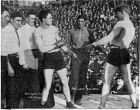 
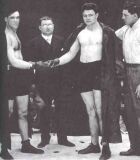
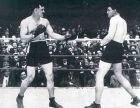

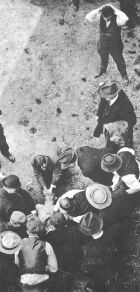

Tracy Callis Profiles: Muhammad Ali Jimmy Barry Jim Corbett Jack Dempsey Nonpareil Jack Dempsey Bob Fitzsimmons Joe Frazier Larry Holmes Peter Jackson Jim Jeffries Jack Johnson Sam Langford Sonny Liston Joe Louis Rocky Marciano Jack McCauliffe Kid McCoy Packey McFarland Terry McGovern Billy Miske Tommy Ryan Sailor Tom Sharkey John L. Sullivan Gene Tunney |
| Upcoming Fights | Current Champions | Boxing Journal | On-line Encyclopedia | News | Home |